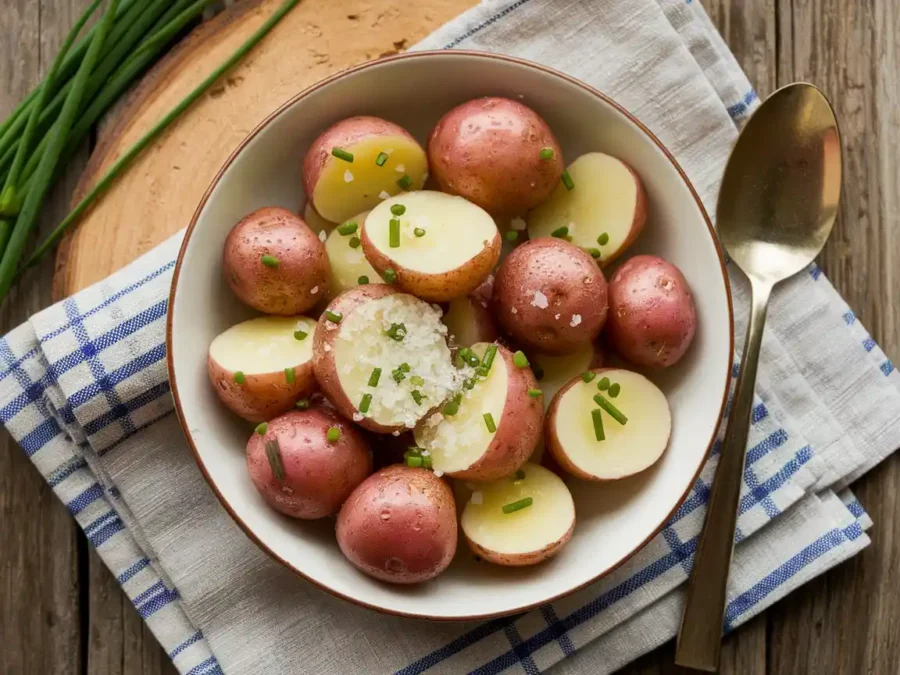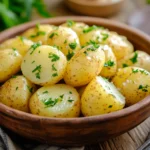Steamed potatoes simple, wholesome, and packed with nutrients are an underrated star in the world of cooking. Whether you’re aiming for a healthy side dish, a hearty main course, or an ingredient that adapts to diverse cuisines, steamed potatoes deliver every time. But what makes them so special, and how can you perfect them at home? This guide dives deep into everything you need to know about steamed potatoes, from their health benefits to troubleshooting tips, all served with a side of creativity. 🍽️
Table of Contents
Why Steamed Potatoes Are a Healthy Choice
Potatoes often get a bad rap, but steaming elevates their nutritional profile, making them one of the healthiest ways to enjoy this versatile tuber. Unlike frying or roasting, steaming doesn’t require oil or high heat, which helps preserve their natural goodness.
Nutritional Benefits
Did you know that a medium-sized potato contains more potassium than a banana? Steamed potatoes are brimming with essential nutrients like vitamin C, vitamin B6, and fiber. Since steaming is a gentle cooking method, it ensures that these nutrients aren’t lost during preparation.
“Potatoes, when steamed, are like nature’s energy capsule rich in nutrients, free from unnecessary additives, and endlessly satisfying.”
Potatoes are also naturally low in fat and cholesterol-free. When steamed, they retain a high water content, which keeps them light and filling. This makes them an excellent choice for anyone watching their weight or looking for a post-workout meal.
How Steaming Preserves Nutrients in Potatoes
Other cooking methods, like boiling, often leach out water-soluble vitamins such as vitamin C. Steaming, however, uses minimal water, ensuring that these vitamins remain intact. The result? A nutrient-packed potato that tastes as good as it is healthy. 😋
The Science Behind Perfectly Steamed Potatoes
Steaming potatoes might seem simple, but there’s actually a bit of science behind getting them just right. Understanding the type of potato, the equipment you’re using, and the steaming process itself can make all the difference.
Types of Potatoes Best for Steaming
Not all potatoes are created equal, and the type you choose affects the texture and flavor of your steamed dish. Here’s a quick rundown:
- Waxy potatoes (like red or fingerling potatoes): These hold their shape well and have a creamy texture, making them perfect for salads or sides.
- Starchy potatoes (like Russets): These tend to be fluffier when steamed, ideal for mashing or serving as a standalone dish.
- All-purpose potatoes (like Yukon Gold): A versatile choice that balances firmness and fluffiness.
Tools and Equipment Needed for Steaming Potatoes
Steaming potatoes doesn’t require fancy gadgets. Here’s what you’ll need:
- A steamer basket: Fits inside a pot to hold the potatoes above the water.
- A saucepan or pot: Big enough to hold the steamer basket.
- A lid: Helps trap steam for efficient cooking.
No steamer basket? No problem. You can improvise by using a colander that fits into your pot or even placing a few small ramekins in the bottom of the pan as a base for your potatoes.
How to Steam Potatoes: Step-by-Step Instructions

Now that you’ve got the tools and ingredients, let’s dive into the process of steaming potatoes to perfection.
Preparing Potatoes for Steaming
Start by selecting potatoes of uniform size for even cooking. Wash them thoroughly under running water to remove dirt, and peel them if desired. However, keeping the skins on retains more nutrients and adds a rustic touch.
Time and Temperature for Optimal Steaming
Timing is everything. Here’s a general guideline for steaming:
- Small potatoes or diced pieces: 10–15 minutes
- Medium-sized whole potatoes: 20–25 minutes
- Large potatoes: 30–35 minutes
Make sure the water in your pot is at a rolling boil before placing the steamer basket inside. Cover the pot tightly to trap the steam. Check for doneness by piercing the potatoes with a fork they should feel tender but not mushy.
“Patience is key when steaming potatoes; rush the process, and you’ll miss out on their full potential.”
Common Mistakes to Avoid When Steaming Potatoes
Even the simplest techniques can go awry. Avoid these pitfalls:
- Overcrowding the steamer basket: Leave enough space for steam to circulate.
- Using too little water: Ensure there’s enough water to last through the steaming process without drying out.
- Skipping the lid: Trapping steam is crucial for even cooking.
Delicious Recipes Using Steamed Potatoes
Steamed potatoes might be simple, but their versatility is where they shine. They can take center stage in a meal or complement other dishes beautifully. Whether you prefer classic comfort food or an adventurous twist, there’s a recipe for everyone.
Classic Steamed Potatoes with Butter and Herbs
Sometimes, simplicity is the best. To make the perfect steamed potatoes with butter and herbs:
- Start with freshly steamed baby potatoes.
- Toss them in melted butter while they’re still warm.
- Sprinkle with freshly chopped parsley, dill, or chives.
- Add a pinch of salt and freshly cracked pepper for seasoning.
This dish is timeless ideal as a side for roast chicken, grilled fish, or even a cozy stew. Want to elevate it further? Try finishing with a drizzle of truffle oil or a sprinkle of grated Parmesan.
Steamed Potato Salad with a Twist
Forget the mayo-heavy versions. A light, vinaigrette-dressed potato salad brings out the best in steamed potatoes. Here’s a quick recipe:
- Steam small red potatoes and let them cool slightly.
- Slice them into halves or quarters, depending on size.
- In a bowl, whisk together olive oil, Dijon mustard, lemon juice, and a touch of honey.
- Toss the potatoes in the dressing, along with capers, thinly sliced red onion, and chopped fresh herbs like parsley or tarragon.
This salad is tangy, fresh, and perfect for picnics or barbecues. 🍋
“Potato salad gets a glow-up when you use steamed potatoes they absorb flavors without turning soggy.”
Creative Dishes Featuring Steamed Potatoes
Looking to push boundaries? Steamed potatoes can be the star of innovative dishes:
- Steamed Potato Hash: Dice steamed potatoes, sauté with onions, bell peppers, and smoked paprika, and serve with a poached egg on top.
- Potato and Spinach Frittata: Layer steamed potato slices in a skillet with sautéed spinach, pour over beaten eggs, and bake until set.
- Steamed Potato Tacos: Mash steamed potatoes with garlic and chili powder, then stuff them into tortillas with salsa and avocado for a unique taco filling.
Solving Common Problems When Steaming Potatoes
Even the best cooks face occasional hiccups when steaming potatoes. Let’s tackle those pesky problems head-on so you can avoid culinary disasters.
Why Do Steamed Potatoes Turn Out Mushy?
Mushy potatoes are often the result of overcooking. To prevent this:
- Stick to recommended steaming times.
- Keep a close eye on the potatoes during the final minutes.
- Use a fork to test for doneness when it slides in easily but meets slight resistance, they’re perfect.
If your potatoes do end up mushy, don’t fret. Use them to make mashed potatoes, potato cakes, or even soup. Waste not, want not!
How to Prevent Overcooking or Undercooking Potatoes
Consistency is key. To achieve perfectly steamed potatoes:
- Cut evenly: Uniform sizes cook at the same rate.
- Don’t overcrowd: Give your potatoes enough space to cook evenly.
- Monitor water levels: Ensure there’s enough water to generate continuous steam but not so much that it touches the potatoes.
Tips for Enhancing the Flavor of Steamed Potatoes
While steamed potatoes are delicious on their own, a few simple tricks can elevate their flavor to gourmet levels. Ready to unlock their full potential? 🌟
Adding Seasonings and Herbs to Steamed Potatoes
Steaming offers a clean slate for flavoring. Try these combinations:
- Garlic and rosemary: Add whole garlic cloves and sprigs of rosemary to the steamer basket for infused aroma.
- Spiced butter: Mix melted butter with smoked paprika, cumin, and a dash of cayenne for a smoky kick.
- Citrus zest: Grate lemon or orange zest over the potatoes just before serving for a fresh, zesty twist.
Pairing Steamed Potatoes with Main Dishes
Steamed potatoes are a fantastic companion to almost any meal. Pair them with:
- Grilled salmon for a light, heart-healthy dinner.
- Roast beef for a classic meat-and-potato combination.
- Veggie stir-fry for a satisfying vegetarian plate.
Their mild flavor absorbs sauces beautifully, so don’t be shy about experimenting.
“Think of steamed potatoes as the ultimate culinary wingman they make everything else taste better.”
Steamed Potatoes in Different Cuisines

Steamed potatoes may seem humble, but they’ve found a place in culinary traditions across the globe. Their versatility allows them to absorb flavors and spices, making them a canvas for diverse dishes.
Steamed Potatoes in European Cooking
In Europe, steamed potatoes often serve as a staple side dish. In Germany, they’re a key ingredient in dishes like Kartoffelsalat (potato salad), where steamed potatoes are combined with mustard, vinegar, and bacon for a hearty accompaniment. Scandinavian cuisines also highlight steamed potatoes paired with fresh dill, pickled herring, or butter.
In France, you’ll find steamed potatoes in dishes like Pommes Vapeur, where they’re dressed simply with butter and parsley. This minimalist approach celebrates the natural flavor of high-quality potatoes.
How Steamed Potatoes Are Used in Asian Dishes
Asian cuisines have their own unique takes on steamed potatoes. In India, they’re often spiced with turmeric, cumin, and coriander, then served as a side dish or stuffed into dosas (fermented rice crepes). In Japanese cuisine, you might find them steamed and served with a soy-based dressing or added to soups like miso for a comforting twist.
for Korea, steamed potatoes are sometimes mashed with sesame oil and soy sauce for a side dish that’s nutty, savory, and slightly sweet.
“From buttery European sides to spice-laden Asian dishes, steamed potatoes truly bridge cultural gaps on the dinner table.”
Frequently Asked Questions
Steamed potatoes often inspire curiosity among cooks. Let’s tackle some of the most common questions about preparing and enjoying them.
Are Steamed Potatoes Better Than Boiled Potatoes?
Yes, they are! Steamed potatoes retain more nutrients because they’re not submerged in water during cooking. They also have a better texture, staying firm yet tender, unlike boiled potatoes, which can sometimes turn waterlogged or mushy.
Can You Steam Potatoes Without a Steamer?
Absolutely. If you don’t have a steamer basket, you can use a colander placed over a pot of boiling water. Another trick is to use a heatproof plate or small rack elevated inside a pot. Cover with a lid, and voilà you have a makeshift steamer.
What’s the Best Way to Store Leftover Steamed Potatoes?
Store steamed potatoes in an airtight container in the refrigerator for up to 3–4 days. To reheat, you can steam them again for a few minutes or warm them in the microwave. Avoid leaving them at room temperature for too long, as this can promote bacterial growth.
Can You Freeze Steamed Potatoes?
Yes, but with caution. Freezing can alter the texture, making them slightly grainy. If you plan to freeze steamed potatoes, use waxy varieties like red potatoes, which hold up better. Thaw them in the fridge overnight and reheat gently.
How Do You Keep Steamed Potatoes from Sticking?
Ensure the potatoes are evenly spaced in the steamer basket to allow for proper circulation. You can also lightly oil the basket before adding the potatoes.
What Are the Best Potatoes for Steaming?
Waxy potatoes like red or fingerling varieties work best for steaming because they hold their shape well. Yukon Gold is another excellent choice for its balance of creaminess and structure.
Conclusion
Potatoes are a timeless and versatile ingredient that fits seamlessly into countless dishes. Whether you’re seeking a quick and healthy side dish, a base for more complex recipes, or just a simple way to enjoy their natural flavors, steaming is one of the best methods to prepare them. This cooking technique preserves their nutrients, enhances their texture, and allows for a variety of flavors to shine through with minimal effort.
From traditional recipes with butter and herbs to innovative creations that pair them with global flavors, this humble ingredient offers limitless possibilities in the kitchen. The ease of preparation and their adaptability to different cuisines make them a staple worth exploring.
Cooking should always strike a balance between nourishment and enjoyment, and these little gems deliver on both fronts. They remind us that the simplest ingredients often hold the most potential, and with a bit of creativity, they can transform any meal into something truly special. So, embrace this versatile food and let it inspire your next culinary adventure!
Steamed Potatoes
Ingredients
- 4 medium potatoes Yukon Gold, red, or baby potatoes
- 1 teaspoon salt optional
- 1 tablespoon butter or olive oil optional
- 1 teaspoon chopped parsley or chives optional
Instructions
- Wash and scrub the potatoes thoroughly.
- Cut potatoes into halves or quarters for faster steaming.
- Fill a pot with about 2 inches of water and bring it to a simmer.
- Place a steamer basket over the pot, ensuring the water does not touch the potatoes.
- Add the potatoes to the steamer basket.
- Cover with a lid and steam for 15-20 minutes or until fork-tender.
- Remove from the steamer and let cool slightly.
- Season with salt, butter, or olive oil as desired.
- Garnish with fresh herbs and serve warm.
Notes
- Serve with your favorite dips, such as sour cream or yogurt-based sauces.
- Add garlic or lemon zest for extra flavor.
- Store leftovers in an airtight container for up to 3 days.


